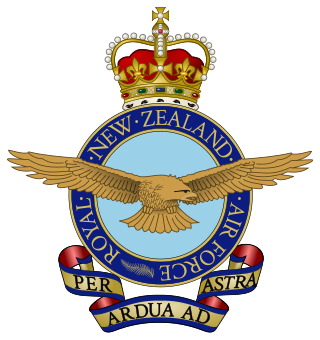
The Royal New Zealand Air Force is the aerial service branch of the New Zealand Defence Force. It was formed initially in 1923 as a branch of the New Zealand Army, being known as the New Zealand Permanent Air Force, becoming an independent air force on 1 April 1937.

Royal Air Force Brize Norton or RAF Brize Norton in Oxfordshire, about 75 mi (121 km) west north-west of London, is the largest station of the Royal Air Force. It is close to the village of Brize Norton, and the towns of Carterton and Witney.
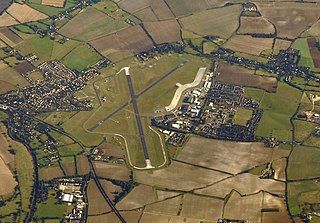
Royal Air Force Benson or RAF Benson is a Royal Air Force (RAF) station located at Benson, near Wallingford, in South Oxfordshire, England. It is a front-line station and home to the RAF's fleet of Westland Puma HC2 support helicopters, used primarily for the transportation of troops & equipment. Flying squadrons comprise No. 33 Squadron flying the Puma, No. 22 Squadron which provides operational evaluation and training for all aircraft in Joint Helicopter Command and No. 28 Squadron, which is the combined Puma and Boeing Chinook HC6A training unit. Other units include the Oxford University Air Squadron and No. 6 Air Experience Flight, both flying the Grob Tutor T1 light training aircraft used for student and cadet flying training. The National Police Air Service and the Thames Valley Air Ambulance are also based at the station, both operating Airbus H135 helicopters.
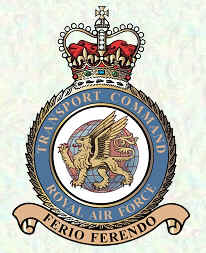
RAF Transport Command was a Royal Air Force command that controlled all transport aircraft of the RAF. It was established on 25 March 1943 by the renaming of the RAF Ferry Command, and was subsequently renamed RAF Air Support Command in 1967.
No. 42 Squadron is an active transport squadron of the Royal New Zealand Air Force (RNZAF). It was formed at Rongotai Airport (Wellington) in December 1943 to provide a communications service around New Zealand, initially using impressed civilian types. It was briefly officially disbanded in 1946, but its aircraft continued with general purpose operations at RNZAF Station Ohakea. When reformed, the squadron was equipped with various numbers of North American Harvard, Auster, Grumman Avenger, Airspeed Oxford, de Havilland Devon, North American P-51 Mustang and Douglas Dakota aircraft.

Number 4 Squadron, normally written as No. IV Squadron, is a squadron of the Royal Air Force. Since November 2011, it has operated the BAE Hawk T2 from RAF Valley, Anglesey, Wales. The squadron provides weapons and tactics training for student pilots after they have completed their conversion to jet aircraft with No. XXV(F) Squadron. Between 1970 and January 2011, No. IV Squadron operated various marks of the Hawker Siddeley Harrier and British Aerospace Harrier II.
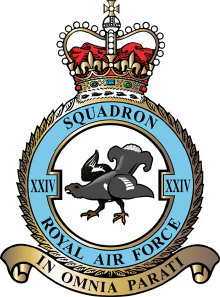
No. 24 Squadron (also known as No. XXIV Squadron) of the Royal Air Force is the Air Mobility Operational Conversion Unit (AM OCU). Based at RAF Brize Norton in Oxfordshire, 24 Squadron is responsible for aircrew training on A400M Atlas and C17 Globemaster. The squadron also delivers or oversees engineer training for these aircraft.

RAF Andover is a former Royal Flying Corps and Royal Air Force station in England, 2 miles (3.2 km) west of Andover, Hampshire. As well as RFC and RAF units, units of the Aviation Section, U.S. Signal Corps, Royal Canadian Air Force, United States Army Air Forces, and the Air Transport Auxiliary were also stationed at the airfield.

The Hawker Siddeley HS 780 Andover is a twin-engined turboprop military transport aircraft produced by Hawker Siddeley for the Royal Air Force (RAF), developed from the Avro-designed HS 748 airliner. The Andover was named after the Avro Andover, a biplane transport used by the RAF for medical evacuation between the first and second world wars; and RAF Andover, where some of its trials were carried out. The Andover had a kneeling landing gear to make ramp loading easier.

The Central Flying School (CFS) is the Royal Air Force's primary institution for the training of military flying instructors. Established in 1912 at the Upavon Aerodrome, it is the longest existing flying training school. The school was based at RAF Little Rissington from 1946 to 1976. Its motto is Imprimis Praecepta, Latin for "The Teaching is Everlasting".

MoD Boscombe Down(ICAO: EGDM) is the home of a military aircraft testing site, on the south-eastern outskirts of the town of Amesbury, Wiltshire, England. The site is managed by QinetiQ, the private defence company created as part of the breakup of the Defence Evaluation and Research Agency (DERA) in 2001 by the UK Ministry of Defence (MoD).

No. 60 Squadron of the Royal Air Force was formed in 1916 at Gosport. It is currently part of No. 1 Flying Training School based at RAF Shawbury in Shropshire flying the Airbus H135 Juno HT.1.
Patricia Magill was the first regular British Women's Royal Air Force officer to wear an aircrew brevet ("wings") and therefore the first to serve in the General Duties (Flying) Branch.

No. 1417 Flight RAF was an independent flight of the Royal Air Force which existed between 1941 and 1993 at various times in a variety of roles. This Flight had probably the most interesting incarnations of all the independent aircraft flights of the Royal Air Force, introducing new technologies and operating complex fast jet aircraft in challenging and austere conditions, from the Arabian Peninsula to Central America.
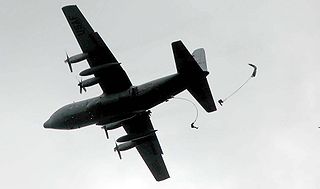
On 9 November 1971, a Royal Air Force Lockheed Hercules C.1 crashed into the sea off the coast of Livorno by Meloria shoal, Italy, killing all 46 passengers and 6 crew. At the time it was described by Italian officials as the worst military air disaster in Italy in peacetime.
Squadron Leader Nicola Elizabeth Smith is a retired British Royal Air Force officer. She was the first female military helicopter pilot in the United Kingdom and in 2002 she became the first female to command a flying squadron.

The UK Military Flying Training System (UKMFTS) takes UK armed forces aircrew from initial training through elementary, basic, and advanced flying training phases, preparing them for their arrival at their designated operational aircraft units. It is operated by Ascent Flight Training, a consortium of Lockheed Martin and Babcock International under a 25-year Private Finance Initiative (PFI) contract for the UK's Ministry of Defence (MoD), with oversight from the MoD. The airworthiness authority for each aircraft type, for example, is fulfilled by military and civilian staff within Defence Equipment and Support. Apart from the overall contract, the main elements of the system include fixed-wing elementary, multi-engine and fast-jet pilot training, rear crew training and rotary-wing (helicopter) training.

No. 3 Flying Training School is a Royal Air Force military training school, which manages elementary flying training for the Royal Navy and Royal Air Force and also for the training of all non-pilot aircrew for the RAF and is home to the Central Flying School Tutor Squadron.
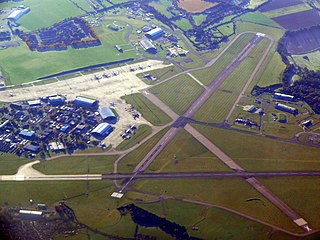
Royal Air Force Lyneham otherwise known as RAF Lyneham was a Royal Air Force station located 6.3 miles (10.1 km) northeast of Chippenham, Wiltshire, and 10.3 miles (16.6 km) southwest of Swindon, Wiltshire, England. The station was the home of all the Lockheed C-130 Hercules transport aircraft of the Royal Air Force (RAF) before they were relocated to RAF Brize Norton.
Group Captain Anne-Marie Houghton is an RAF officer and was the RAF's first female fully qualified navigator in 1991.















